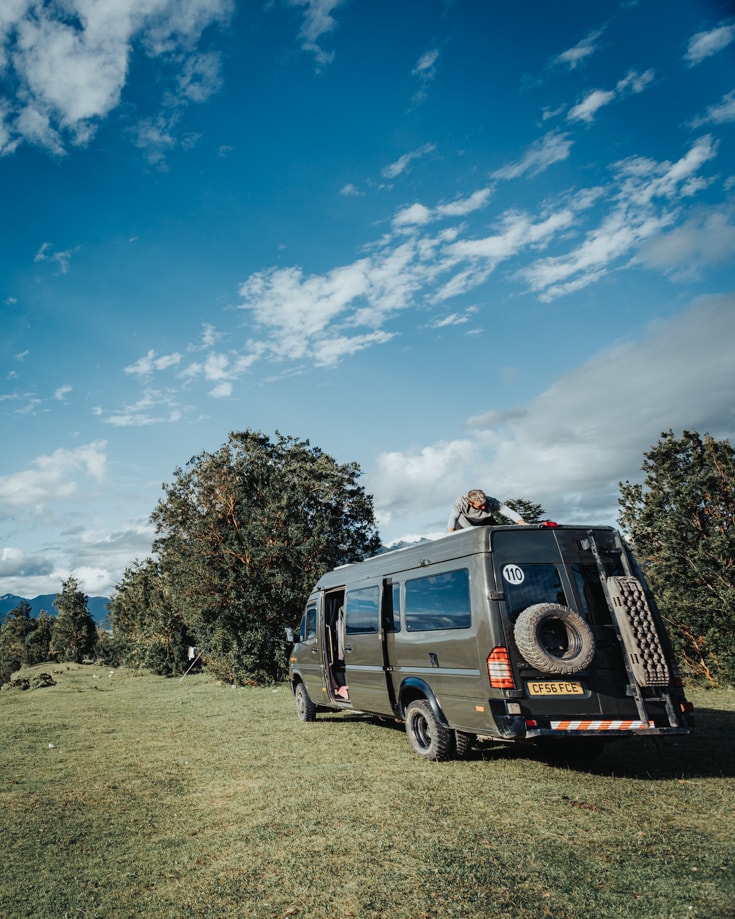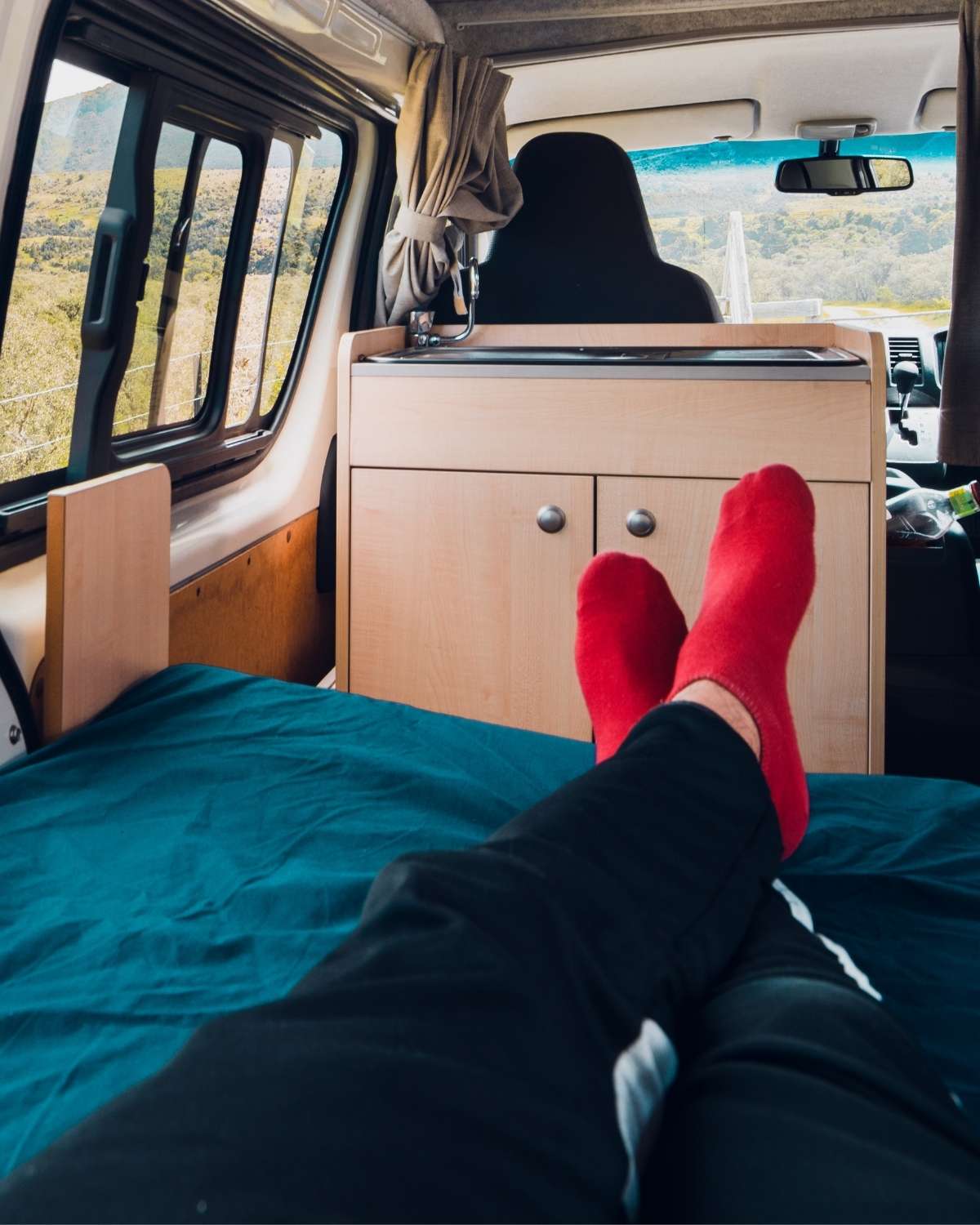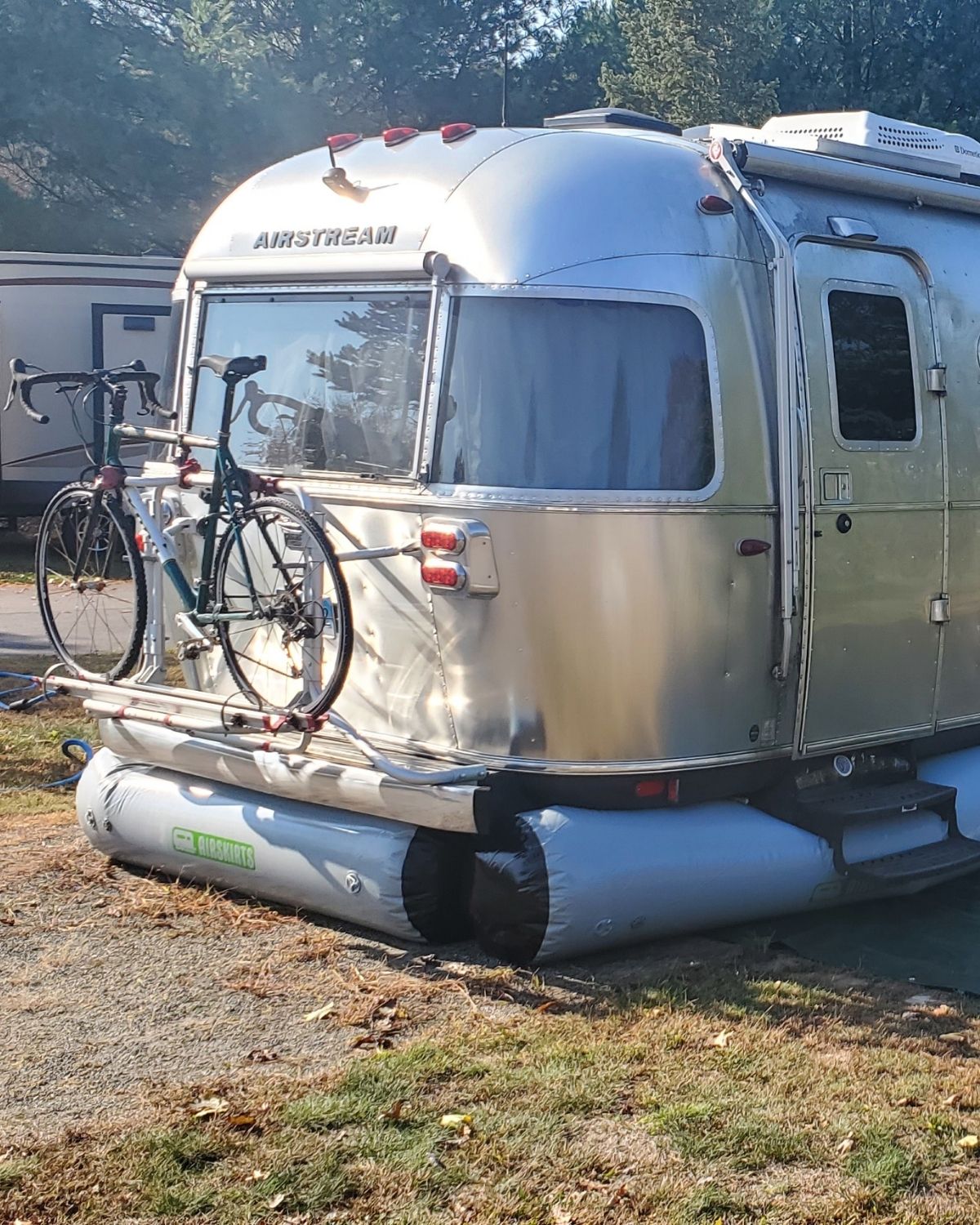Should you have a campervan with a toilet or without?
Many van dwellers adapt to living in a van without an onboard toilet. Others wouldn’t leave their drive without a fitted toilet.
Whether you want a full-size bathroom, an emergency use only solution, or something in between boils down to the size of your van, how much space you’re willing to give up for luxury and personal preference.
Installing a full-size bathroom will add to the cost of the build. Some camper toilets need accessories that’ll add to van life costs.
Other options are free but not so luxurious.
So is a toilet one of your campervan essentials? Do you even know what your campervan toilet options are?
Keep reading for more toilet talk and the campervan toilet options available to you.
Do You Need A Toilet In Your Campervan?
Before seriously considering installing a bathroom or toilet facility in your campervan, ask yourself if you really need one.
As with every other aspect of building a van to live in, deciding to install a toilet is personal to your lifestyle.
Campervan toilets can take up a fair amount of space. Even if you don’t fit a separate toilet cubicle, you need to store the toilet somewhere.
If you also want to store bikes or surfboards inside your camper van, the space becomes quite precious.
Most campsites have toilet facilities so consider how often you’ll even use them. Sure it’s great to have an onboard toilet but it’s not the end of the world if you don’t.
Not all campervans have a toilet and their owners manage well enough.
So let’s take a look at all campervan toilet options, the pros and cons of each, and the best buys available.

What To Do If You Don’t Have A Camper Toilet
When you click on links to various merchants on this site and make a purchase, this can result in this site earning a commission. As Amazon Associates, we earn from qualifying purchases. For more info, please check our disclosure page.
There are public bathrooms almost everywhere. Fuel stations, shopping centers, supermarkets, and restaurants. Even National Parks and tourist attractions have normal toilet facilities.
So most of the time, you can use public toilets.
Some public facilities aren’t as hygienic or well-stocked as you might like so bring your own toilet tissue and hand sanitizer.
Unless you’re on a campsite, going in the night can be more of a challenge.
If you’re in the wilderness, it’s easy to go behind a tree or bush. Going out in the middle of the night when it’s cold, raining, blowing a gale or you’re likely to encounter any local wildlife isn’t great though.
The alternative is to use a “pee pot”. It’s easier for men to pee in a bottle but women can use a jar with a wide opening and it’s just as good.
Make sure your pee pot of choice has a screw-on lid to avoid messy spillages.
Some women swear by the Go Girl while others hate them.
What About When You Want To Poop?

Hopefully, you won’t pass up the opportunity to use one of the many public toilets. In a built-up area, finding one shouldn’t be a problem.
If you’re out in the wilderness though, it’s time to dig a hole! You’ll need a shovel but a small trowel works just as well.
Dig a small hole, aim well, do your business, then cover up the hole. Don’t leave your toilet tissue though.
Instead of leaving it to find its way into the local water source or attract wild animals to your camp, wrap it in an extra layer of toilet tissue and bin it.
Or you can now buy these portable bidets and save on toilet paper altogether.
Pros
- Free
- Uses no space inside your campervan
- Avoids the emptying hassle
Cons
- No solution if you get caught short
- Roughing it like this isn’t for everyone
Bucket or Bag Toilets for Campers
If you think you’re unlikely to use an onboard toilet, have you thought about what happens if you’re caught short or have a stomach upset?
Being sick when living in a van is dreadful but if you’ve nowhere to go when nature calls, it’s even worse.
There are a lot of bucket toilets on the market but many of them don’t collapse so take up as much space as a campervan composting toilet or porta potti.
They may be ok for camping trips but not for inside a campervan.
Instead, choose one that folds away to a compact size, so to take up little storage space in the van. Even if you never use it, it’s not taking up more space than it’s worth.
This portable folding toilet is little more than a stool with a hole in the seat. Pop a biodegradable plastic bag over the seat and take a pew. Use 2 bags to prevent leaks. All puns intended!
Seal the bag after use and throw it in the waste.
Bucket toilets are definitely not a solution for everyday use but will cover you in an emergency situation.
For something a little more robust, but along the same lines, the Cleanwaste Portable Toilet and the Reliance Fold-To-Go Toilet fold away for safe and discreet storage too.
I wouldn’t worry too much about how these things look – literally nobody but you is ever going to see them.
Pros
- Cheap
- Needs little storage
- Easy to dump
- You could probably make one yourself
Cons
- Folding toilet is not very elegant
- Probably pretty smelly
- Not sealed tight so risk of spillages
- Not an everyday toilet solution
Portable Toilets for Campervans
A portable toilet (or chemical toilet or porta-potti) is more of a long-term toilet solution for campervans.
Portable toilets don’t need electricity and each unit is self-contained, so you can take them out of the van for emptying and cleaning.
They’re quite small so ideal when space is limited in small campervans. If you camp in one place for a few days at a time and have a toilet tent, you could even have it set up outdoors.
Chemical toilets are made up of 3 main parts.
- The holding tank – holds the crap (and everything else) in a chemical solution
- Fresh water tank and pump – filled with water and disinfectant to flush
- Seat – your throne.
You need to open a hatch between the seat and the holding tank to make sure your deposits are directed to where they belong.
Always make sure to close the hatch when you’re done. You don’t want that stuff sloshing around as you drive.
Then you have the joy of emptying it! Check out our practical, tongue-in-cheek guide on how to empty a portable camping toilet.
Chemicals are needed to break down the deposits, so you’ll need to store the bottles in your van too.
Here are 3 of the best selling portable toilets:
We had a chemical toilet installed in Mowgli, our old Unimog camper. To be honest, we just didn’t get on with it.
We always thought we could smell it and Graham found the emptying of it so traumatic (it was his job), we barely used it.
We feel we’d have been better off saving the space and going with a bucket toilet or committing to a composting toilet.
Pros
- Cheap
- Lightweight and small
- Completely sealed when hatch closed
- No electric or battery supply needed
Cons
- Chemicals can be expensive and in some parts of the world (like South America) impossible to buy
- Emptying is horrid
- Finding a dump station is difficult (almost impossible in South America)
- Not environmentally friendly
Campervan Composting Toilets

When we converted our Sprinter van, Baloo, we got rid of the chemical portable toilet and upgraded it to a portable campervan composting toilet.
It takes up more space than a porta-potti so more suited to larger campervans and RVs.
The pee and poop are kept separate to help eliminate any nasty odors. The pee is diverted into a separate pee pot and can be emptied easily.
Most of the solid deposits into a portable toilet consist of little more than water, regardless of how it looks!
A composting toilet works by evaporating most of the liquid and the rest decomposes with the help of a little fertilizing substance like soil or coco coir and a small fan to keep air circulating inside the poop box and extracted out of the vent pipe.
The portable toilet needs a bit of setup. It needs an electric supply – don’t worry though it uses almost nothing. The vent pipe needs a hole to the outside of the vehicle too.
Dumping the poop is an infrequent, easy and comparatively, clean job compared to the chemical toilet too.
Because it contains no chemicals, dumping is easy too.
In our opinion, a composting toilet is the best portable toilet for a campervan.
The Nature’s Head Composting Toilet is one of the most popular portable composting toilets for campervans and RVs.
Pros
- No smells
- Easy dumping
- Eco friendly
- Doesn’t need water
- Completely sealed
Cons
- Expensive
- Installation isn’t straight forward, needing electric supply and a hole in the van
- Need to carry a supply of coco coir
- Uses quite a lot of space
Cassette Toilets for Campervans
A cassette toilet (or cartridge toilet) is in many ways similar to a portable chemical toilet, without portability.
The portable toilet unit is fixed permanently in the van but the waste tank is portable. Access to the waste tank is usually from outside of the van through a hatch.
This way, you don’t need to carry your waste tank full of poop through your home. These cassette toilets are popular in North America and Europe too.
To do away with the need for chemicals you can retrofit a device called a SOG. It adapts your cassette toilet so it works in a similar way to a composting toilet.
Emptying a portable cassette toilet is exactly the same as a chemical toilet aside from how you access the holding tank.
The most popular brands of cassette toilets are Thetford and Dometic who do a wide range. Here are a few couples of models to choose from:
- Thetford 32812 C402C Cassette Toilet
- Dometic CTW 4110 Cassette Toilet
Pros
- Cheaper than a composting toilet
- If a SOG is fitted it’s eco-friendly and can be dumped in any toilet
- Permanent toilet solution
Cons
- Much more expensive than a portable chemical toilet
- Need to build in access hatch to van wall
- Emptying is horrid
- If not fitted with a SOG, finding a dump station is difficult & not eco-friendly
RV Toilets with Holding Tanks
This is a popular option in North America.
The toilet needs a water supply and flushes into a black tank slung under the vehicle.
RV toilets come with 3 types of flush:
- Gravity – you need to fit the toilet directly over the black tank
- Macerating – motor blades turn the solid waste into slurry before it arrives in the black tank
- Vacuum – a bit like an airline toilet, everything is hoovered up to the holding tank.
Chemicals are added to the black tanks to prevent smells from wafting back up into the RV.
Black tanks vary in size from small and compact to enormous 150-gallon tanks. That’s a lot of sh*t and weight to carry around though.
The only responsible way to dump the contents of a black tank is at a dedicated dumping station. There’s no trouble finding these in north America. Some European campsites have facilities too, but it’s somewhat more difficult elsewhere.
Pros
- Easy to replace
- Large tanks need less dumping
- Contents empty through a hose so you don’t need to touch much
Cons
- Finding somewhere to responsibly dump waste is a challenge outside of USA
- Needs a water supply and some need an electric supply too
- Not eco-friendly
- Large tanks size can add significant weight when full – see how extra weight affects your campervan build
What To Do With Used Toilet Paper and Feminine Hygiene Products
Used toilet paper and feminine hygiene products need to be disposed of responsibly.
If you do your business in the woods, leave no trace. Wrap all your used toilet paper in a bag or an extra layer of toilet paper and throw it in the bin.
With bucket or bag toilets, it’s safe to throw it in with your waste and dispose of it altogether.
If you have a chemical toilet – cassette, portable, or an RV toilet – anything you throw down the pan can potentially reduce the effectiveness of the chemicals by soaking them up.
It’ll also help fill up the tanks faster, leading to more frequent dumping – something we all want to avoid.
The same applies to composting toilets.
We suggest you have a small bin with a lid conveniently located beside your camper toilet and lined with low-cost, slightly scented doggy poop bags. This is exactly what we do and we empty the bin as needed.
How to Decide Which Campervan Toilet Option is Right for You

If you’re in the planning stage of your camper van conversion, now is the perfect time to decide which toilet option is right for you.
But there’s no one size fits all solution so all we can do is try to help you decide.
In our opinion, there are plenty of perfectly suitable eco-friendly campervan toilet options available to avoid chemicals. We encourage you to choose from the greener options:
- No toilet installed
- Bucket or bag toilet
- Composting toilet
- Cassette toilet with fitted SOG
If space is a premium:
- No toilet installed
- Bucket or bag toilet
If you want a permanent solution but don’t have the space for a bathroom:
- Cassette toilet with fitted SOG fitted in a fixed cupboard
If you have the space for a bathroom:
- Composting toilet
- Cassette toilet with fitted SOG fitted in a fixed cupboard
And if you’ve bought a van with black tanks already fitted, please don’t be the muppet who thinks it’s ok to dump umpteen gallons of your waste on the roadside.
Either locate an RV dump or use one of the other campervan toilet options instead until you find a responsible place to empty it.
Graham Bogie

Graham is a seasoned marine electrical engineer with two decades of experience designing customized electrical systems for plant machinery and converting campers and overland vehicles. His expertise has led him to author the reputable Campervan Electrics Handbook and become the chief designer of the RV Wiring Design Tool. As a knowledgeable figure in the field, his YouTube channel, blog, Facebook group, and newsletter, offering electrical advice and product reviews, reach more than a million users each year.




